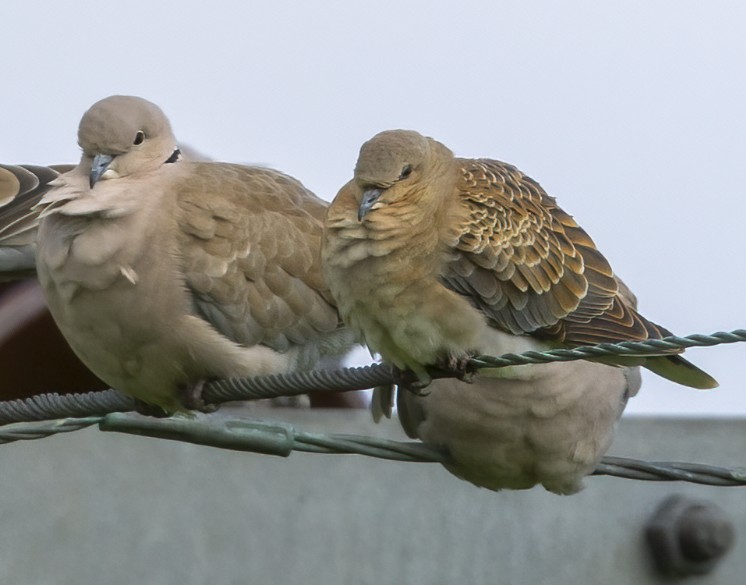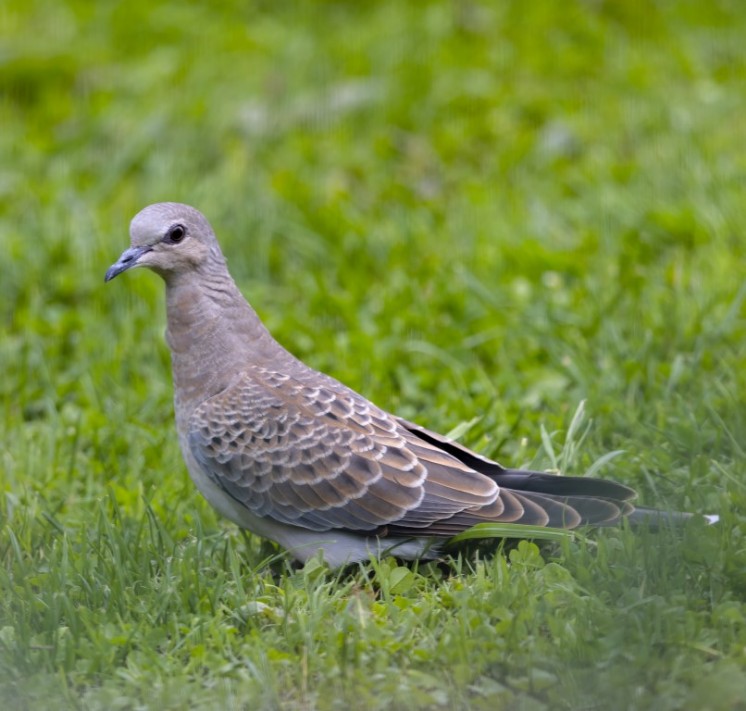Turtle Dove on Arran
Reports

On Monday 12 September a juvenile Turtle Dove appeared in Sliddery along with the familiar Collared Doves. It looked a bit lethargic. The Turtle Dove is a dainty dove, much smaller and darker than the Collared Dove - slightly larger than a blackbird. Its upperparts are distinctively mottled with chestnut and black, and its black tail has a white edge. The Turtle Dove has a "purring" call, and its name comes from Latin turtur which is an onomatopoeic representation of the bird’s song. The name has no connection to the reptile, turtle. This juvenile Turtle Dove enjoyed the feeding provided in Sliddery gardens and perked up until on Saturday 17 September it left, hopefully heading south for the winter. Both photographs were taken by Mike Fenton.
The Arran Natural History Society records go back over forty years. Turtle Dove first appears in Arran records in 1979 when there was one in Lamlash from 17th to 24th May. There were three records in the 1980s, none in the 1990s, five in the 2000s and three in 2010s, the last one being on Clachaig Farm on 20 September 2015. The longest staying bird was one in a Brodick garden again with Collared Dove from 25th October to 8th November 2006. All records have been of single birds with records split almost evenly between spring and autumn.
Arran reflects Scotland. In Scotland, European Turtle Dove is a scarce passage migrant in both spring and autumn. Winter records are very rare. A few pairs nested in south-eastern Scotland from the middle of the 20th century up to the 1980s but there have been no breeding reports since. Numbers on passage are in decline.
The Turtle Dove is the only long-distance migratory dove species in Europe with a range covering most of Europe and the Middle East including Turkey and North Africa. It is rare further north in Scandinavia and Russia. It winters south of the Sahara. Populations of turtle dove are in rapid decline across Europe and this species has red list conservation status globally. In the United Kingdom its numbers have declined by 93% since 1994 and across Europe, numbers fell by 78% 1980–2013. Research in the UK last year revealed that there were now an estimated 2,100 pairs, down from 125,000 in 1970.
Factors that may be influencing this rapid and sustained population decline include, lack of seed and grain during the breeding season, resulting in a much shorter breeder season with fewer nesting attempts and hunting during migration and in wintering areas.
This highly endangered species is able to be hunted in ten EU Member States, Austria, Bulgaria, Cyprus, France, Greece, Italy, Malta, Portugal, Romania and Spain where around 2 million are legally shot every year. Turtle Dove is also huntable in other European countries like Bosnia-Herzegovina, Montenegro, North Macedonia, Serbia, Turkey and Ukraine. There is more information here. The SOS of the European Turtle-dove - BirdLife International
